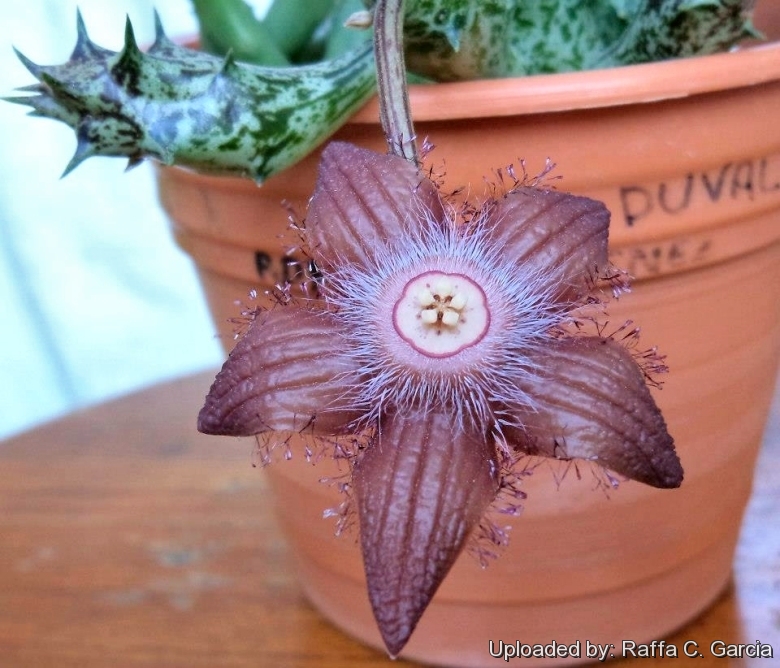
Duvalia sulcata Photo by: Raffa C. Garcia
Origin and Habitat: Duvalia sulcataSN|30343]]SN|30343]] (ssp. sulcata) has a disjunct distribution in southern Yemen and in Sudan.
Habitat and ecology: The plants prefer a well drained granite soil, though they can tolerate sandier conditions in the shade of shrubs or small bushy acacias. It is also a character-species of substitutional vegetation on ruderal sites.
Synonyms:
See all synonyms of Duvalia sulcata
Description: Duvalia sulcataSN|30343]]SN|30343]] is the most beautiful, large-flowered duvalia. It is a succulent, perennial plants with low, planar growth with branches rooting at the base and can form wide carpets which, at the right moment, can carry many flowers. The shoots are mottled grey-green with long soft teeth and four-angled in cross-section. The hermaphroditic flowers are ca. 3 cm long, opened to 4.5 cm in diameter and are characterized by the flat brownish red annulus with long, white hairs. The corolla lobes have 5 deep nerves on the upper side and are fringed with long red and white club-hairs at the base. These club-hairs hardly remain still and move in the slightest breeze, possibly attracting insects. However the stems and the corolla size, colour and indumentum are quite variable. D. sulcata differs from the African species by its quadrangular stems and very large flowers. It might belong to its own growth-form group.
Stems: Reclining to upright, 2-8(-10) cm long, 1-2 cm in diameter, forming adventitious roots. up to 6.5 cm long, branching into runners at the base, green, gray-green or blue-green, with reddish spots, and long, acute teeth.
Roots: Fibrous.
Inflorescences: Extra-axillary (usually at basal flanks of stems), 1-3-flowered. Pedicel 1-4 cm long, glabrous arising from near the centre or base of a stem.
Flowers: With foetid odour, not nectariferous, on the ground. Corolla 3-4.5 cm in diameter, variable in colouration, greenish, ochre, pale maroon, reddish-brown or pale chestnut-brown, shiny. Corolla lobes 10-18 mm long, 7-12 mm wide, lamina flatly spreading, with 5 longitudinal furrows on the upper surface, apex finely papillate. Margins slightly reflexed, with vibratile clavate hairs. Hairs 1.5-2.5 mm long. Annulus circular, weak, 7-14 mm in diameter,1-1.5 (-2) mm high- densely hairy, Hairs white to pale pink, simple, 5-8 mm long. Corona disc 6-8 mm in diameter,. round. 5- to 10-angled, covering the annulus almost entirely, Cs lobes white or cream. 2.2 - 4 x 1.4 - 2.2 mm. outer appendages very acute, erect (slightly curved inwards). Pollinia 0.35 - 0.5 x 0.3 mm.
Fruits: Seed pods (follicles), usually appearing as twin horns up to a year after flowering, acute-angled, 12-16 cm long, 7-8 mm in diameter, fusiform, terete, apically acute, but not beaked, wingless, smooth, decorative.
Seeds: 6 mm long by 3-4 mm in width, greyish-brown.
Subspecies, varieties, forms and cultivars of plants belonging to the Duvalia sulcata group
Duvalia sulcata form a very variable complex. 3 or 4 subspecies can be recognized as geographically and morphologically (to a wide extent) clearly distinct entities.
Bibliography: Major references and further lectures:
1) Focke Albers, Ulrich Meve “Illustrated Handbook of Succulent Plants: Asclepiadaceae: Asclepiadaceae” Volume 4 Springer, 2002
2) Ulrich Meve, Focke Albers “The species concept in Duvalia (Asclepiadaceae): A preliminary revision of the genus” In: Mitteilungen aus dem Institut für Allgemeine Botanik in Hamburg. 23: 595–604.1990.
3) Sheila Collenette “An illustrated guide to the flowers of Saudi Arabia” Scorpion, 1985
4) Werner Rauh “The Wonderful World of Succulents: Cultivation and Description of Selected Succulent Plants Other Than Cacti” Smithsonian Institution Press, 1984
5) Bruyns, P. V. 2005. "Stapeliads of Southern Africa and Madagascar", vol. 1: 68-81.
6) Meve, U. 1997. "The genus Duvalia (Stapelieae)", 130 pp, Springer, Wien.
 Duvalia sulcata Photo by: Raffa C. Garcia
Duvalia sulcata Photo by: Raffa C. Garcia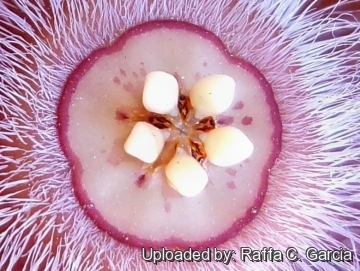 Corona. Photo by: Raffa C. Garcia
Corona. Photo by: Raffa C. Garcia Duvalia sulcata Photo by: Luiza Ferreira
Duvalia sulcata Photo by: Luiza Ferreira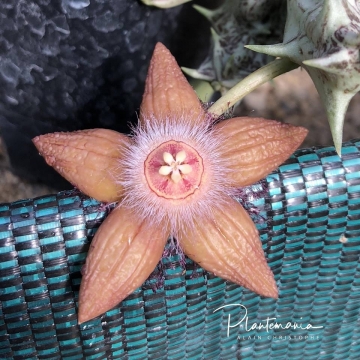 Duvalia sulcata ssp sulcata (Yemen) Photo by: © Plantemania
Duvalia sulcata ssp sulcata (Yemen) Photo by: © Plantemania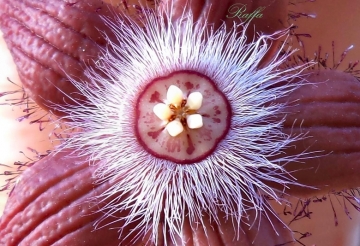 Duvalia sulcata Photo by: Raffa C. Garcia
Duvalia sulcata Photo by: Raffa C. Garcia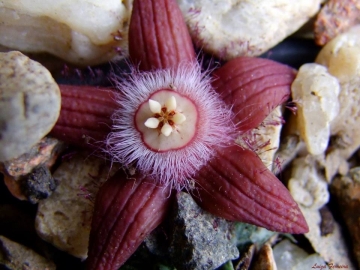 Duvalia sulcata Photo by: Luiza Ferreira
Duvalia sulcata Photo by: Luiza Ferreira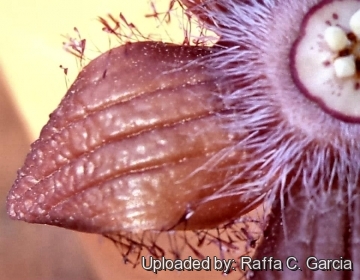 Duvalia sulcata Photo by: Raffa C. Garcia
Duvalia sulcata Photo by: Raffa C. GarciaSend a photo of this plant.The gallery now contains thousands of pictures, however it is possible to do even more. We are, of course, seeking photos of species not yet shown in the gallery but not only that, we are also looking for better pictures than those already present.
Read More... Cultivation and Propagation: Duvalia sulcata is an easy obliging blooming plant when mature, that it is happy in any average succulent house.
Potting:Since roots are quite shallow, use a soft and incoherent cactus mix or add extra perlite or pumice to regular soil potting soil, and clay pots help the plants to dry out between watering.
Waterings: Duvalia require moderately watering through the growing season but enjoy plenty of water and some fertiliser in hot weather, this helps them to flower freely. Water more sparingly in winter according to temperatures. But, as with most asclepiads, it is unwise to leave them wet in cold weather.
Fertilization: Fertilizers for succulent plants must be rich in potassium, but poor in nitrogen, to avoid the plants from developing excess vegetation, which is easily attacked by fungal diseases.
Sun Exposure: As with many succulents, they prefer to grow in the light shade of scrubby shrubs or between rocks where they get some shade during the day. In summer it is advisable to position this plant in a partially shady place, where it is exposed to direct sunlight only during the coolest hours of the day.
Hardiness: These plants don't like cold weather, therefore in the Spring it is best to set them outside only when the temperatures are above 15°C. Can endure temperatures below 5°C for short period, but only if the soil stays completely dry.
Pest and diseases: Duvalia species vary in their susceptibility to rotting, but are generally fairly easy to grow, especially if kept pest-free. They are very susceptible to stem and root mealy bugs, and damage from these may well initiate fungal attack. If you do have problems with a stem or with basal rotting, you can reliably isolate the healthy parts, dry them off, and re-root them in moist compost.
Cultural Practices: Re-pot every 2 years.
Propagation: Easiest with stem cuttings. Allow cuttings to dry a day before planting. Stems must be laid (Not buried) on gritty compost and will then root from the underside of the stems. It can also be increased from seeds sowing in spring in moist, sandy peat moss. Barely cover seeds. Seeds germinate quickly.


















